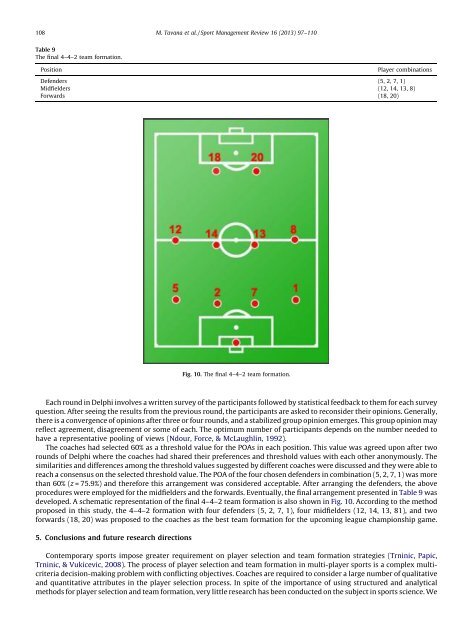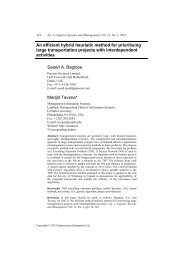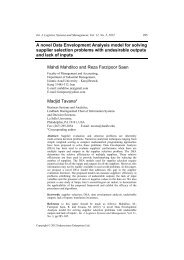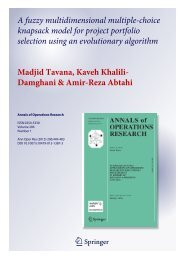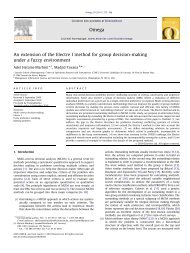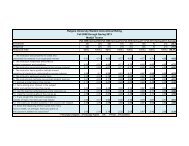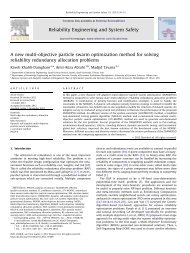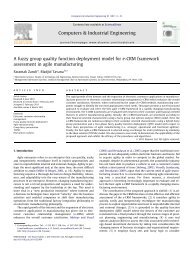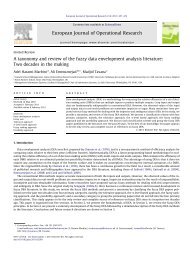108M. Tavana et al. / Sport Management Review 16 (2013) 97–110Table 9The final 4–4–2 team formation.Position Player combinationsDefenders (5, 2, 7, 1)Midfielders (12, 14, 13, 8)Forwards (18, 20)Fig. 10. The final 4–4–2 team formation.Each round in Delphi involves a written survey of the participants followed by statistical feedback <strong>to</strong> them for each surveyquestion. After seeing the results from the previous round, the participants are asked <strong>to</strong> reconsider their opinions. Generally,there is a convergence of opinions after three or four rounds, <strong>and</strong> a stabilized group opinion emerges. This group opinion mayreflect agreement, disagreement or some of each. The optimum number of participants depends on the number needed <strong>to</strong>have a representative pooling of views (Ndour, Force, & McLaughlin, 1992).The coaches had selected 60% as a threshold value for the POAs in each position. This value was agreed upon after tworounds of Delphi where the coaches had shared their preferences <strong>and</strong> threshold values <strong>with</strong> each other anonymously. Thesimilarities <strong>and</strong> differences among the threshold values suggested by different coaches were discussed <strong>and</strong> they were able <strong>to</strong>reach a consensus on the selected threshold value. The POA of the four chosen defenders in combination (5, 2, 7, 1) was morethan 60% (z = 75.9%) <strong>and</strong> therefore this arrangement was considered acceptable. After arranging the defenders, the aboveprocedures were employed for the midfielders <strong>and</strong> the forwards. Eventually, the final arrangement presented in Table 9 wasdeveloped. A schematic representation of the final 4–4–2 team formation is also shown in Fig. 10. According <strong>to</strong> the methodproposed in this study, the 4–4–2 formation <strong>with</strong> four defenders (5, 2, 7, 1), four midfielders (12, 14, 13, 81), <strong>and</strong> twoforwards (18, 20) was proposed <strong>to</strong> the coaches as the best team formation for the upcoming league championship game.5. Conclusions <strong>and</strong> future research directionsContemporary sports impose greater requirement on <strong>player</strong> <strong>selection</strong> <strong>and</strong> team formation strategies (Trninic, Papic,Trninic, & Vukicevic, 2008). The process of <strong>player</strong> <strong>selection</strong> <strong>and</strong> team formation in multi-<strong>player</strong> sports is a complex multicriteriadecision-making problem <strong>with</strong> conflicting objectives. Coaches are required <strong>to</strong> consider a large number of qualitative<strong>and</strong> quantitative attributes in the <strong>player</strong> <strong>selection</strong> process. In spite of the importance of using structured <strong>and</strong> analyticalmethods for <strong>player</strong> <strong>selection</strong> <strong>and</strong> team formation, very little research has been conducted on the subject in sports science. We
M. Tavana et al. / Sport Management Review 16 (2013) 97–110 109proposed a two-phase framework for <strong>player</strong> <strong>selection</strong> <strong>and</strong> team formation in soccer. The <strong>player</strong>s were selected in the firstphase <strong>and</strong> the best combinations of the selected <strong>player</strong>s were evaluated <strong>with</strong> a FIS for team formation. We presented a casestudy <strong>to</strong> demonstrate the applicability of the proposed framework <strong>and</strong> exhibit the efficacy of the procedures <strong>and</strong> algorithms.The contribution of the proposed method is threefold: (1) it addresses the gaps in the sport science literature on the effective<strong>and</strong> efficient <strong>player</strong> <strong>selection</strong> <strong>and</strong> team formation; (2) it considers imprecise or vague judgments which lead <strong>to</strong> ambiguity inthe decision process; <strong>and</strong> (3) it uses a meaningful <strong>and</strong> robust multi-criteria model <strong>to</strong> aggregate both qualitative judgments<strong>and</strong> quantitative data.The proposed framework does not imply a higher-level of ‘accuracy’ in <strong>player</strong> <strong>selection</strong> <strong>and</strong> team formation. While ourapproach enables the coaches <strong>to</strong> assimilate the precise data <strong>and</strong> imprecise or ambiguous judgments in<strong>to</strong> a formal <strong>system</strong>aticapproach, it should be used <strong>with</strong> care <strong>and</strong> in conjunction <strong>with</strong> the game objectives. Our approach helps the coaches <strong>to</strong> think<strong>system</strong>atically about complex multi-criteria decision making problems <strong>and</strong> improves the quality of their decisions. Thecoaches’ judgment is an integral component of <strong>player</strong> evaluation; therefore, the effectiveness of the model relies heavily onthe cognitive capabilities of the coaches.Although the case study in this paper considered two fac<strong>to</strong>rs as inputs in the FIS, the approach permits a large degree offlexibility <strong>to</strong> integrate additional fac<strong>to</strong>rs in the evaluation process. The methodology discussed in this paper is not onlysuitable for multi-<strong>player</strong> sports, it is also appropriate for modeling workgroups <strong>and</strong> project teams in business <strong>and</strong> industry.In conclusion, we stress that our contribution addresses yet a small part of the issues that are involved <strong>with</strong> arranging <strong>player</strong>sin multi-<strong>player</strong> sports. It is safe <strong>to</strong> say that quantitative <strong>and</strong> analytical <strong>player</strong> <strong>selection</strong> <strong>and</strong> team formation as a discipline is atits infancy. Therefore, we hope that the study presented here can inspire others <strong>to</strong> pursue further research in this area.AcknowledgementsThe authors would like <strong>to</strong> thank the anonymous reviewers <strong>and</strong> the edi<strong>to</strong>r for their insightful comments <strong>and</strong> suggestions.ReferencesAhmed, F., Deb, K., & Jindal, A. (2011). Evolutionary multi-objective optimization <strong>and</strong> decision making approaches <strong>to</strong> cricket team <strong>selection</strong>. In Proceedings of theSecond International Conference on Swarm, Evolutionary, <strong>and</strong> Memetic Computing. Berlin, Heidelberg: Springer-Verlag http://dx.doi.org/10.1007/978-3-642-27242-4_9.Arnason, A., Sigurdsson, S. B., Gudmundsson, A., Holme, I., Engebretsen, L., & Bahr, R. (2004). Physical fitness, injuries, <strong>and</strong> team performance in soccer. Medicine &Science in Sports & Exercise, 36, 278–285.Askin, R. G., & Sodhi, M. (1994). Organization of teams in concurrent engineering. In R. D. Dorf & A. Kusiak (Eds.), H<strong>and</strong>book of design, manufacturing, <strong>and</strong> au<strong>to</strong>mation(pp. 85–105). New York: John Wiley & Sons.Baldwin, D. C. (1994). The role of interdisciplinary education <strong>and</strong> teamwork in primary care <strong>and</strong> health care reform. Rockville, MD: Health Resources <strong>and</strong> ServicesAdministration, Bureau of Health Professions. Order No. 92-1009(P).Boon, B. H., & Sierksma, G. (2003). Team formation: Matching quality supply <strong>and</strong> quality dem<strong>and</strong>. European Journal of Operational Research, 148, 277–292.Braha, D. (2002). Partitioning tasks <strong>to</strong> product development teams. Paper presented at the International Design Engineering Technical Conferences of American Societyof Mechanical Engineers (DETC’02 ASME).Chen, Y. L., Cheng, L. C., & Chuang, C. N. (2008). A group recommendation <strong>system</strong> <strong>with</strong> consideration of interactions among group members. Expert Systems <strong>with</strong>Applications, 34, 2082–2090.Chen, S. J., & Lin, L. (2004). Modeling team member characteristics for the formation of a multifunctional team in concurrent engineering. IEEE Transactions onEngineering Management, 51(2), 111–124.Cohen, S. G., & Bailey, D. E. (1997). What makes teams work: Group effectiveness research from the shop floor <strong>to</strong> the executive suite. Journal of Management, 23,239–290.Dalkey, N. C., & Helmer, O. (1963). An experimental <strong>application</strong> of the Delphi Method <strong>to</strong> the use of experts. Management Science, 9, 458–467.DeKorvin, A., Shipley, M., & Kleyle, R. (2002). Utilizing <strong>fuzzy</strong> compatibility of skill sets for team <strong>selection</strong> in multi-phase projects. Journal of Engineering <strong>and</strong>Technology Management, 19, 307–319.Dereli, T., Baykasoglu, A., & Das, S. (2007). Fuzzy quality-team formation for value added auditing: A case study. Journal of Engineering <strong>and</strong> Technology Management,24, 366–394.Dubois, H. P. (1978). Operations on <strong>fuzzy</strong> numbers. International Journal of Systems Science, 9(6), 613–626.Durmusoglu, M., & Kulak, O. (2008). A methodology for the design of office cells using axiomatic design principles. Omega, 36, 633–652.English, A., Griffith, R. L., & Steelman, L. A. (2004). Team performance: The effect of team conscientiousness <strong>and</strong> task type. Small Group Research, 35(6), 643–665.Feng, B., Jiang, Z. Z., Fan, Z. P., & Fu, N. (2010). A method for member <strong>selection</strong> of cross-functional teams using the individual <strong>and</strong> collaborative performances.European Journal of Operational Research, 203, 652–661.Fischer, R. (1978). The Delphi Method: A description, review <strong>and</strong> criticism. Journal of Academic Librarianship, 4(2), 64–70.Fried, B. J., Topping, S., & Rundall, T. G. (2000). Groups <strong>and</strong> teams in health service organisations. In S. M. Shortell & A. D. Kalunzny (Eds.), Health care management:Organisation design <strong>and</strong> behavior (pp. 154–190). Albany: Delmar Thomson Learning.Gronau, N., Fröming, J., Schmid, S., & Rüssbüldt, U. (2006). Approach for requirement oriented team building in industrial processes. Computers in Industry, 58(2),179–187.Ho, D. W. C., Zhang, P. A., & Xu, J. (2001). Fuzzy wavelet networks for function learning. IEEE Transactions on Fuzzy Systems, 9, 200–211.Horikawa, S., Furuhashi, T., & Uchikawa, Y. (1992). On <strong>fuzzy</strong> modelling using <strong>fuzzy</strong> neural networks <strong>with</strong> the back-propagation algorithm. IEEE Transactions onNeural Networks, 3(5), 801–806.Huang, S. J., & Chiu, N. H. (2009). Applying <strong>fuzzy</strong> neural network <strong>to</strong> estimate software development effort. Applied Intelligence, 30(2), 73–83.Karsak, E. (2000). A <strong>fuzzy</strong> multiple-objective programming approach for personnel <strong>selection</strong>. Paper presented at the 2000 IEEE International Conference on Systems,Man, <strong>and</strong> Cybernetics.Katzenbach, J. R., & Smith, D. K. (1993). The wisdom of teams. Bos<strong>to</strong>n: Harvard Business School Press.Keeney, S., Hasson, R. E., & McKenna, H. (2006). Consulting the oracle: 10 lessons from using the Delphi Technique in nursing research. Journal of Advanced Nursing,53(2), 205–212.Kinlaw, D. C. (1991). Developing superior work teams. San Diego: Lexing<strong>to</strong>n Books.Kirkman, B. L., Rosen, B., Tesluk, P. E., & Gibson, C. B. (2004). The impact of team empowerment on team performance: The moderating role of face-<strong>to</strong>-faceinteraction. Academy of Management Journal, 47(2), 175–192.Lee, C.-C. (1990). Fuzzy logic in control <strong>system</strong>s: Fuzzy logic controller-Part I. IEEE Transactions on Systems, Man, <strong>and</strong> Cybernetics, 20, 404–418.


